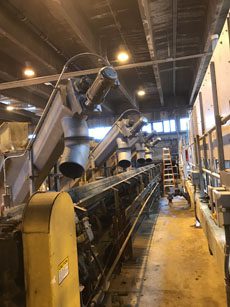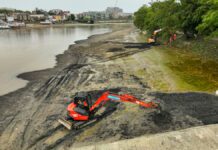US based Lakeside Equipment, which manufacturers equipment for the water sector, sets out the details of a recent contract win, supplying grit classifiers for a utility in Washington DC.

At the largest treatment plant of its kind in the world, it’s no surprise perhaps that they use some of the biggest grit classifiers available, with the final two of 16 newly installed units now commencing operation.
For this important yet simple technology, DC Water set the bar extremely high to ensure that its new grit classifiers would work reliably and effectively for many years to come at the 150-acre Blue Plains site.
Averaging 300 million treated gallons per day (and 847 million gallons per day at peak flow thru headworks), this highly advanced wastewater treatment Plant had seen its existing grit classifiers (installed in 2002) outstay their welcome. Rising levels of downtime, maintenance and cleaning required fresh investment.
The classifiers had structural defects, causing leaking and a housekeeping problem. Each and every time a unit had to be taken off-line to open up the hatch, take the screw out, get inside to clean it, buckle in a new liner and ultimately, weld it. All very laborious.
Via 1,800 miles of sewers from around the District and from the Potomac Interceptor, wastewater arrives at Blue Plains from a large sewer that begins at Dulles Airport – also bringing with it wastewater from the suburbs of Maryland and Virginia along the way.
Following a series of screens and a grit removal system that removes objects and large articles, the grit classifiers are at the sharp end of conveying grit and other non-degradable particles.
With the grit classifiers having become one of Blue Plains biggest maintenance issues, DC Water set out an open bid, determined to find out who could bring the best possible long-term solution.
After a comprehensive investigation, particularly into the quality of manufacturing, a shortlist of eight and then later three suppliers was drawn up, from which Lakeside Equipment Corporation was finally chosen.
“DC Water was working with a simple design, which they liked, but knew needed modifying”, explained Dan Widdel from Lakeside.
“They knew it was imperative to find a system that would be stronger and much easier to maintain. Sixteen grit classifiers each handling a grit slurry flow rate of 400 Gallons per Minute (gpm) is a big deal”.
“From the outset”, added Widdel, “our design proposal went into great detail about what we could offer and how we could best work together. At Lakeside we have made it our business to respond quickly and professionally to questions, which although we take nothing for granted, is second nature to us. A grit classifier might be considered a simple piece of equipment, but that doesn’t mean that compromises should be made on its construction”.
‘Welding and structural integrity’
With standards of construction so essential to the very detailed bid package, Lakeside (established 1928) was not only able to demonstrate vast experience with grit classifiers, but more importantly, the flexibility to adapt to DC Water’s design. After the deterioration of the existing grit classifiers, DC Water was keen to see the quality of welding and structural integrity of Lakeside’s work.
Unlike the previous shaftless screw design which sits on an interior liner and can wear through, Lakeside’s helical screw design is shafted all the way through, supported by a bearing at the bottom and a reducer on the top, so that a build-up of sand or grit provide a bed for the screw, eliminating tank lining wear.
As grit slurry is discharged to the Classifier, the grit and water mixture separate to allow grit particles to settle in the tank. A baffle reduces turbulence and prevents short circuiting when the effluent is discharging over the weir. Settled grit is then removed by the helical screw conveyor, equipped with steel flights. Crucially, for a long lifetime, the sectional flights are fabricated with hardened welding on the leading face for durability and strong-wear resistance.
Dan Widdel from Lakeside continued: “What DC Water wanted is a grit classifier that matched up to their existing classifier envelope, which differed from our standard classifier design.”
He added: “This was never a problem though because we custom-build to meet our customer’s needs. Using 3D modeling, our Engineering Department worked alongside DC Water in order to match up the grit classifiers with the existing inlet and outlet pipes to keep the installation process to a minimum while not sacrificing on the performance”.
Lakeside’s capability was one thing, but there was of course a time frame to adhere to – with the added challenge of these being amongst the largest grit classifiers that anyone can make. Delivering the new grit classifiers two-by-two over a three-month period was also geared to meet DC Water’s needs.
’Maintenance is now much easier’
“We listened very closely to DC Water’s issues”, continued Lakeside’s Dan Widdel, “and can see that maintenance is now much easier for their personnel. They have much better access, whereas previously they had limited access to maintain the unit. And instead of all the labor to replace a plastic liner, they now have an automatic lubricator on the end of the bearing.
“Compared to before when they had cracks appearing on their old grit classifiers, they now have complete peace of mind that the new Lakeside structures are sound. In fixing one of the biggest maintenance issues at the largest treatment plant of its kind in the world, we’re confident that DC Water’s search for the right company was very worthwhile”.
More information about the firm is available at www.lakeside-equipment.com.






